How to Make a Fabric Canvas: Crafting Your Own Fabric Canvas is not only a rewarding but also a cost-effective way to customize your art projects.
Whether you are an aspiring artist eager to experiment with new techniques or a DIY enthusiast in search of unique decor pieces, making your own fabric canvas enables you to take control of the quality and size of your canvas.
In this comprehensive guide, we will lead you through the entire process of making a fabric canvas, covering materials, tools, and techniques to guarantee the success of your project.
What Is Canvas Fabric
A fabric canvas serves as the foundation for many forms of art, particularly painting. While pre-stretched canvases are readily available, creating your own offers several benefits, including customization and a deeper connection to your work.
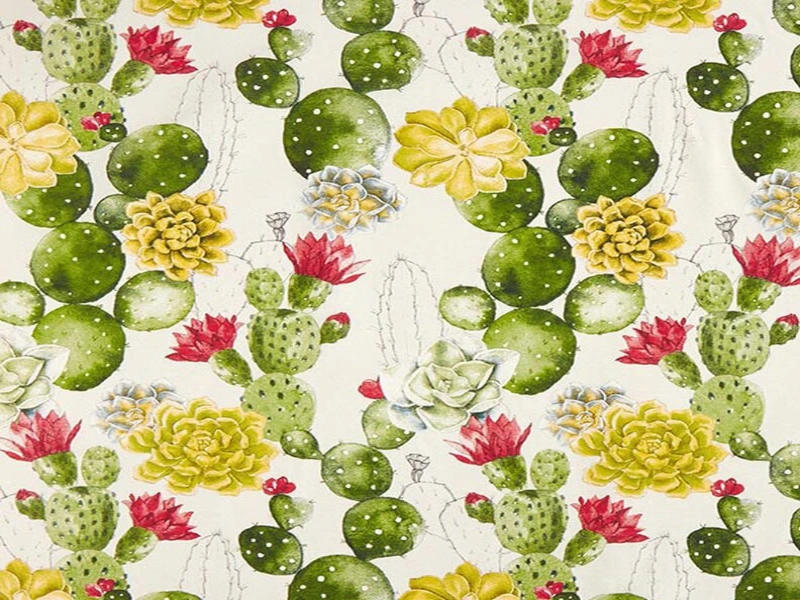
How to Make a Fabric Canvas
This guide will help you understand the steps involved, the materials you’ll need, and the techniques to achieve a professional result.
Materials Needed

To create your own fabric canvas, you’ll need the following materials and tools:
- Canvas Fabric: Choose a high-quality cotton or linen canvas. Cotton is more affordable and versatile, while linen is known for its durability and fine texture.
- Wooden Stretcher Bars: These bars form the frame that will support your canvas. They come in various lengths and can be assembled to create different sizes of canvases.
- Staple Gun and Staples: A staple gun will secure the fabric to the stretcher bars. Use heavy-duty staples for the best hold.
- Pliers: Useful for pulling the fabric taut and adjusting staples if necessary.
- Scissors: For cutting the canvas fabric to size.
- Gesso: A primer that prepares the canvas surface for painting.
- Paintbrushes or Roller: To apply the gesso evenly.
Step-by-Step Guide about How to Make a Fabric Canvas
Step 1: Assemble the Frame
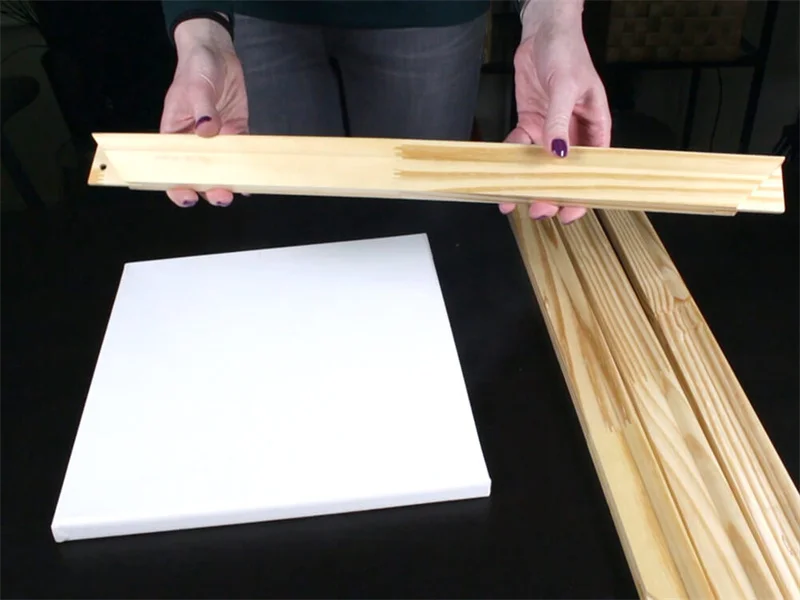
- Choose Your Size: Determine the desired size of your canvas. Stretcher bars are typically sold in standard lengths, so select bars that match your needs.
- Join the Bars: Connect the stretcher bars to form a rectangular or square frame. Most bars have interlocking joints that fit together snugly. Ensure the frame is square by measuring the diagonals; they should be equal.
- Reinforce the Frame: For larger canvases, consider adding cross braces for additional support.
Step 2: Cut the Canvas Fabric
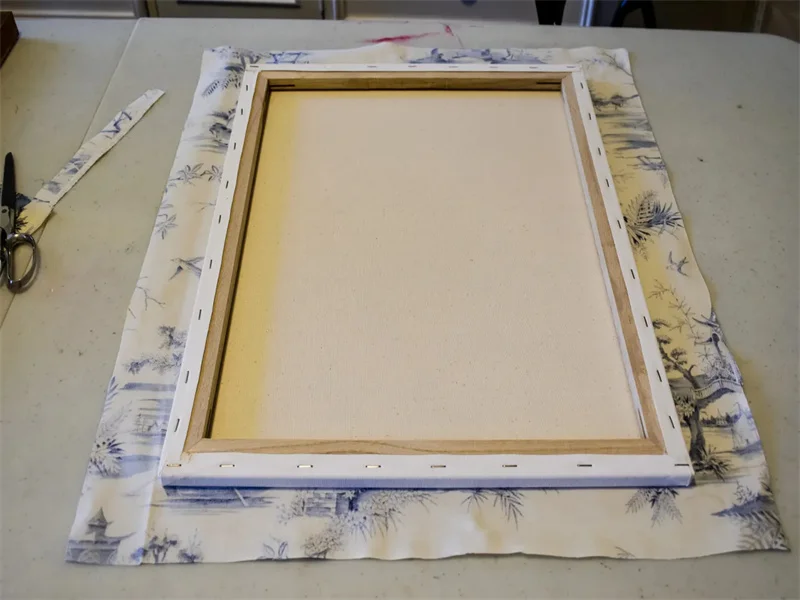
- Measure the Fabric: Lay your canvas fabric on a flat surface. Place the assembled stretcher frame on top, leaving an extra 4-6 inches of fabric on all sides to wrap around the frame.
- Cut the Fabric: Using scissors, cut the canvas to the appropriate size. The extra fabric ensures you have enough material to grip and staple securely.
Step 3: Stretch and Staple the Canvas
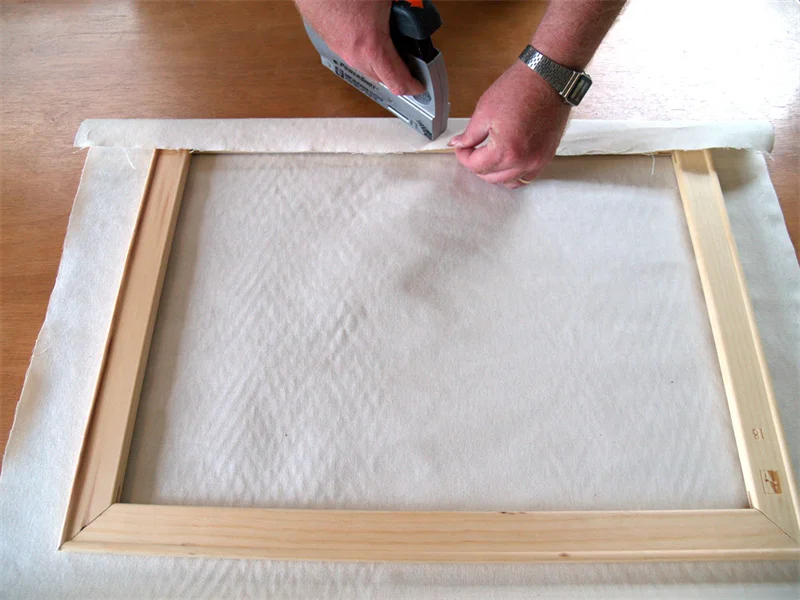
- Position the Canvas: Place the fabric face down on a clean surface. Center the stretcher frame on top of the fabric.
- Staple the Center: Start by stapling the center of one side of the canvas to the back of the stretcher bar. Move to the opposite side, pull the fabric taut, and staple the center. Repeat for the other two sides.
- Continue Stapling: Work your way out from the center staples, alternating sides to maintain even tension. Pull the fabric taut and smooth out any wrinkles as you go.
- Fold the Corners: When you reach the corners, fold the fabric neatly to create a smooth edge and staple securely.
Step 4: Apply Gesso
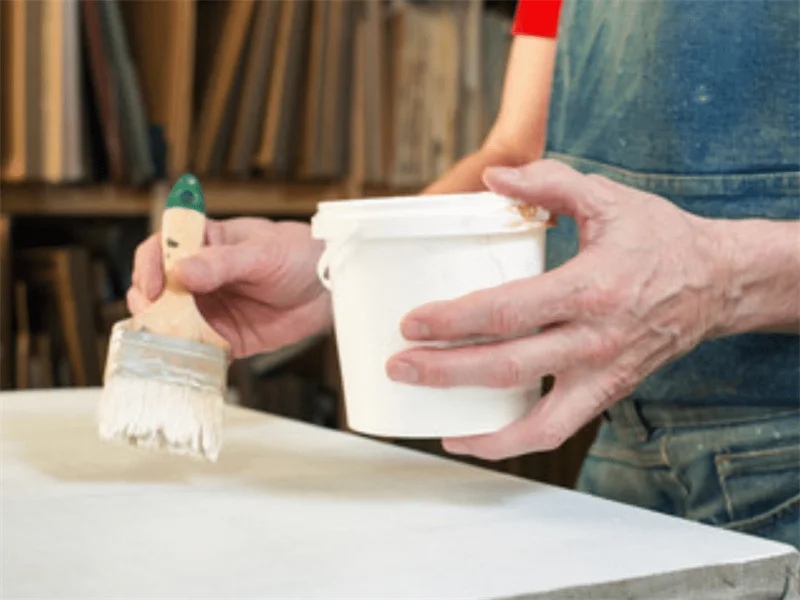
- Prepare the Surface: Once the canvas is stretched and stapled, trim any excess fabric from the edges.
- Apply the First Coat: Using a large paintbrush or roller, apply a thin, even coat of gesso to the entire surface of the canvas. Be sure to cover the edges as well.
- Let it Dry: Allow the first coat of gesso to dry completely. This can take a few hours depending on the humidity and temperature.
- Sand and Repeat: Lightly sand the dried gesso with fine-grit sandpaper to smooth any rough areas. Apply a second coat of gesso and let it dry. Repeat this process for a third coat if desired.
Tips for Success
- Quality Materials: Invest in high-quality canvas fabric and stretcher bars. The better the materials, the longer your canvas will last.
- Even Tension: Ensure the fabric is evenly stretched across the frame. Uneven tension can lead to wrinkles and an unstable painting surface.
- Multiple Coats of Gesso: Applying multiple coats of gesso creates a smoother, more durable painting surface. Sanding between coats helps achieve a professional finish.
- Work in a Clean Space: Dust and debris can get caught in the gesso, so work in a clean area to avoid imperfections.
Creative Ideas for Using Fabric Canvas
- Traditional Painting: Use your handmade canvas for oil, acrylic, or watercolor paintings. The primed surface is perfect for various painting techniques.
- Mixed Media Art: Fabric canvases are ideal for mixed media projects, combining paint, fabric, paper, and other materials.
- Decorative Wall Art: Create unique wall art by stretching patterned or printed fabric over stretcher bars.
- Custom-Sized Canvases: Tailor the size and shape of your canvas to fit specific spaces or project requirements.
Troubleshooting Common Issues
- Wrinkles in the Canvas: If you notice wrinkles while stretching the canvas, pull the fabric taut and smooth out the wrinkles before stapling. For persistent wrinkles, a spray of water can help tighten the fabric.
- Loose Fabric: If the canvas feels loose after stapling, use a staple remover to adjust the fabric tension and re-staple as needed.
- Uneven Gesso Application: Ensure each coat of gesso is applied thinly and evenly. Use a wide brush or roller to avoid streaks and clumps.
Conclusion
Making your own fabric canvas is a rewarding and customizable process that enhances your artistic endeavors. By following this step-by-step guide, you can create high-quality canvases tailored to your specific needs and preferences.
Whether you’re painting, crafting, or decorating, a handmade canvas provides a unique and personal touch to your projects. So gather your materials, prepare your workspace, and start crafting your own fabric canvas today!
